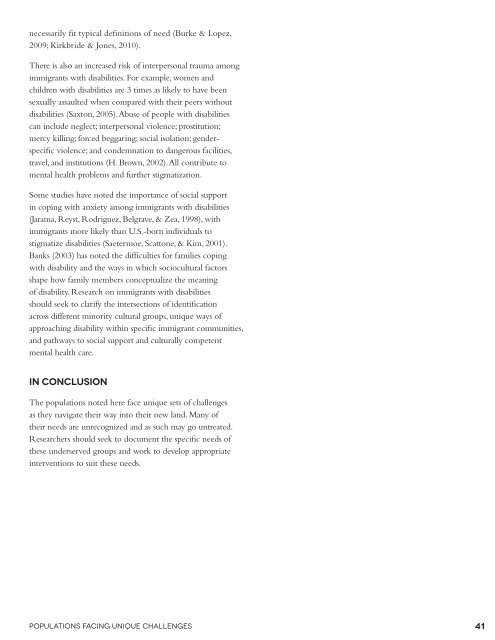Crossroads: The Psychology of Immigration in the New Century
Crossroads: The Psychology of Immigration in the New Century
Crossroads: The Psychology of Immigration in the New Century
You also want an ePaper? Increase the reach of your titles
YUMPU automatically turns print PDFs into web optimized ePapers that Google loves.
necessarily fit typical def<strong>in</strong>itions <strong>of</strong> need (Burke & Lopez,<br />
2009; Kirkbride & Jones, 2010).<br />
<strong>The</strong>re is also an <strong>in</strong>creased risk <strong>of</strong> <strong>in</strong>terpersonal trauma among<br />
immigrants with disabilities. For example, women and<br />
children with disabilities are 3 times as likely to have been<br />
sexually assaulted when compared with <strong>the</strong>ir peers without<br />
disabilities (Saxton, 2005). Abuse <strong>of</strong> people with disabilities<br />
can <strong>in</strong>clude neglect; <strong>in</strong>terpersonal violence; prostitution;<br />
mercy kill<strong>in</strong>g; forced beggar<strong>in</strong>g; social isolation; genderspecific<br />
violence; and condemnation to dangerous facilities,<br />
travel, and <strong>in</strong>stitutions (H. Brown, 2002). All contribute to<br />
mental health problems and fur<strong>the</strong>r stigmatization.<br />
Some studies have noted <strong>the</strong> importance <strong>of</strong> social support<br />
<strong>in</strong> cop<strong>in</strong>g with anxiety among immigrants with disabilities<br />
(Jarama, Reyst, Rodriguez, Belgrave, & Zea, 1998), with<br />
immigrants more likely than U.S.-born <strong>in</strong>dividuals to<br />
stigmatize disabilities (Saetermoe, Scattone, & Kim, 2001).<br />
Banks (2003) has noted <strong>the</strong> difficulties for families cop<strong>in</strong>g<br />
with disability and <strong>the</strong> ways <strong>in</strong> which sociocultural factors<br />
shape how family members conceptualize <strong>the</strong> mean<strong>in</strong>g<br />
<strong>of</strong> disability. Research on immigrants with disabilities<br />
should seek to clarify <strong>the</strong> <strong>in</strong>tersections <strong>of</strong> identification<br />
across different m<strong>in</strong>ority cultural groups, unique ways <strong>of</strong><br />
approach<strong>in</strong>g disability with<strong>in</strong> specific immigrant communities,<br />
and pathways to social support and culturally competent<br />
mental health care.<br />
In Conclusion<br />
<strong>The</strong> populations noted here face unique sets <strong>of</strong> challenges<br />
as <strong>the</strong>y navigate <strong>the</strong>ir way <strong>in</strong>to <strong>the</strong>ir new land. Many <strong>of</strong><br />
<strong>the</strong>ir needs are unrecognized and as such may go untreated.<br />
Researchers should seek to document <strong>the</strong> specific needs <strong>of</strong><br />
<strong>the</strong>se underserved groups and work to develop appropriate<br />
<strong>in</strong>terventions to suit <strong>the</strong>se needs.<br />
Populations Fac<strong>in</strong>g Unique Challenges<br />
41
















